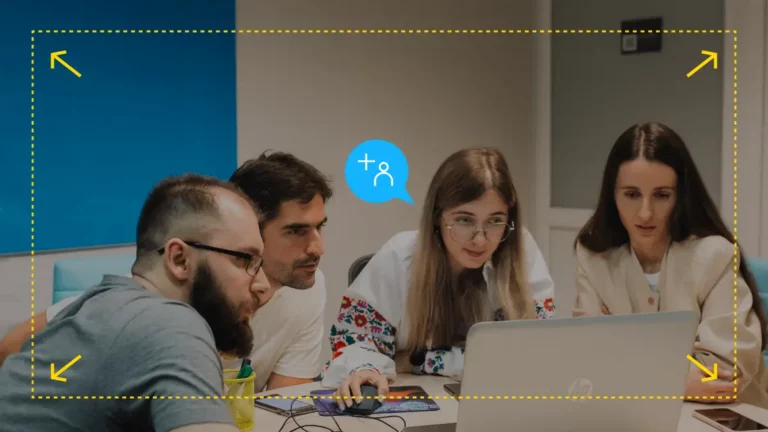16 FAQs about Agile Scrum Distributed Teams
Team distribution becomes a common practice for large tech corporations, startups, and subsidiary projects in big companies. Some companies even operate exclusively on a remote-based model, having their teams working in different corners of the world. Compared to in-house employment, the distributed team brings a much wider variety of talented professionals, excellent qualities of services, and timely delivery. You can either outsource your project or turn to a nearshoring provider and hire a dedicated development team. However, the initial question that comes to mind of entrepreneurs who are considering distributed work is “Can they follow the principles of Agile Offshore Development?”.
Agile Distributed Teams
According to research, as of 2019, 81% of participants in the Information and Communication Technology sector in the world started applying Agile methods in software development. 68% of corporations stated that the principles of Agile increased product time delivery and 42% of the respondents saw considerable improvement in customer overall satisfaction.
Distributed agile teams can benefit and hire Objective C developer and the support of a reliable software development partner, fostering seamless collaboration and productivity in a remote environment. For the last decade or so, a significant amount of investments have been placed to alter national business practices to globally-managed. The move has opened numerous opportunities for companies to invade new marketplaces, hire professionals across the world, and save on labor costs. With this in mind, entrepreneurs started seeing it extremely beneficial to collaborate with distributed teams. Remote teams, dedicated development teams, or geographically dispersed teams are the names that stand for working remotely overseas. The reasons for going international are as follows: the scarcity of talents on the domestic market, insufficient funding, short-term projects or startups that would rather build virtual teams to save money.
Agile for distributed teams requires great contribution in terms of finding management approaches, proper communication tools, as well as progress tracking systems. Above that, clients may face cultural barriers and communication issues. However, if managed and controlled smartly, distributed teams show great success in Agile software development.
The Benefits of Running Distributed Teams: 3 Success Stories
Let’s see the benefits of US firms applying Agile offshore development to their business operations. As of 2018, employers spend approximately $103,000 a year to cover paycheck for software developers, and by offshoring in Ukraine, they will reduce this number to $57,000. Moreover, having about 190,000 specialists presented in the country’s IT market, they will find all range of services: from developers to UI/UX designers, from Data Scientists to Quality Assurance professionals. Most American companies are having a tremendous choice of offshoring services vendors that deliver a fast hiring process taking into account your requirements, needs, and project description details. The tendency of nearshoring is also quite demanding in Western Europe that hires remote teams from the Central and Eastern European countries.
Nearshoring gives the benefits of close proximity, cultural similarities of a client and developers, and a small time difference gap.
Buffer, a platform that helps enterprises build their brands and promote those in social media, is accounting for 85 employees working from 15 different countries with both small and large time gaps. Being located in the US, Ukraine, Great Britain, and Australia, they successfully manage their communication based on trust and loyalty.
esurance, an insurtech startup based in Switzerland currently employs 16 dedicated developers in Ukraine. They managed to grow their staff from 2 employees to 16 in just 2 years through establishing excellent communication and eliminating cultural differences. They liked the model so much that even their CTO is remote.
GitLab, a platform that offers the services of project planning, CI/CD, monitoring and remains a complete application for DevOps. While other companies are having their remote teams in 1-2 countries, GitLab managed to make it 65+ locations with distributed teams.
To add more clarity on how these companies gained world recognition and success by not limiting their employees to one location, let’s answer common questions about how Agile development in distributed teams works.
Question #1: What Is the Recommended Size of an Agile Team?
Most references claim that the optimal number of members of Agile team structure varies from 3 to 9, so you could establish proper communication and collaboration without facing the issues.
You need to make sure that everyone feels valued, the role distribution is clear, each member gets a chance for initiating a change, while, at the same time, it should not become an obstructive factor during project execution.
Question #2: How Does It Work with Distributed Teams?
Although collocated teams are more suitable for Agile software development, distributed teams can be easily managed by establishing successful distributed Agile team working patterns. Remote team does not mean that they have less value to the overall project or require less time to complete the cycles, so it is important to treat them as if they are your in-house employees.
Question #3: Does It Take More Time for Distributed Teams?
One of the greatest advantages of using Agile is that the deadlines and timeframes rather refer to cycles, not to the whole project. However, it is more efficient and easy to meet deadlines in sprints. Agile development remote teams may even show you better results in timing since they are not operating under your close supervision, thus have more flexibility while preserving a high level of responsibility.
Question #4: What Are the Most Widely Used Agile Methods?
Scrum – the most popular Agile methodology which, according to research conducted by Scrum Alliance, is used in 108 countries. Among the survey participants, 77% came from the IT sector who share Scrum manifesto and usefulness. This method is mainly aimed at establishing profound self-organization in teams to work on small project cycles (called Sprints). Before the client approves the cycle, the team itself receives its goals and they define the timing needed for each iteration. Despite the team being self-organized after the client started the cycle, the members require Scrum Master – the leader. If you run distributed teams, remote Scrum Master is an integral part of the project to establish effective communication within the team, organize meetings, implement changes, and report on the progress.
Question #5: How Can You Prevent Cultural Differences in Distributed Teams in Agile?
Whether nearshoring or offshoring, employees hired from another country will be following the patterns of the country they grew up in. In order to avoid issues related to cultural dissimilarities, this matter should be clarified on the stage of hiring your remote team. Make sure you properly set the goals and plans so that the candidates know your intentions and views. Moreover, defining the personal qualities of developers may shed light on their behavior during overcoming challenges. For instance, if the candidate proves to be a good team player, you can be sure that team integration and collaboration will be accomplished.
Question #6: Do Distributed Teams Require More Management?
Actually, it’s not quite correct. In order to make your remote team work for your goals, make it a team – establish proper communication, support them and encourage, provide assistance to make them work on the challenges they face. Due to cultural differences and language barriers, you may be more attentive while managing them, but distributed teams are no different than collocated.
Question #7: How to Communicate with Distributed Teams?
With no doubts behind, face-to-face communication remains the most effective way to establish trust, resolving the issues, planning and implementing a change. Nonetheless, digitalization has brought communication to a whole new level by introducing Slack, TeamViewer, Skype, Microsoft Teams, and a variety of other tools. By cultivating different means of communication, you are able to facilitate overall understanding between team members, resolve the evolving issues promptly, easily define pitfalls at any stage of project development, as well as decrease the distance between you and your employees.
Question #8: How Can I Be Sure of the Quality?
The quality of services provided by distributed teams depends on their level of tech skills and motivation you give them. The first aspects can be defined back on the interviewing stages when your vendor selects the developers referring to your project requirements. Your share in this stage is to give test tasks for the team members to make sure they match your expectations. As of motivation, most developers who are empowered by their employers, show a significant level of devotion, thus, quality takes its place. However, based on Agile principles, the whole process of development includes numerous tasks that can be assessed, analyzed, and checked at any necessary time.
Question #9: How to Manage Agile Processes in Distributed Teams?
Prioritizing communication while working in Agile is necessary, prioritizing communication in distributed teams in Agile is inevitable. In order to make sure you follow the principles of Agile software development smoothly, create an environment for the employees to be on the same wavelength: build a corporate culture, bring both in-house and remote teams together, support initiative, listen to their needs, give freedom and establish trust. Moreover, to gain momentum in Agile, all team members must have defined roles and milestones to know what is their personal goal and contribution to the project.
Question #10: Can a Team Operate Independently without My Involvement?
Absolutely no. Agile team management requires direct and constant interaction with you and the team. Even though most of the time your team is working in a dispatched mode, Agile principles require you to be as much present during meetings as possible. In fact, not only does the project itself need your supervision and expertise but also your developers – they need support, feedback, guidance for the project to flow at a good pace.
Question #11: What Communication Tools Shall I Use?
Clients usually define the mode of communication by agreeing with their team on what works best for them but in any way, they apply more holistic tools than simply meet once a month. With this in mind, clients prefer daily meetings (standups, reviews, showcases) to keep an eye on while the project is executed. Skype is mainly used for video conferencing, Slack – for messaging, TeamViewer – to share the screen with other team members and thus resolve the arising issues timely. Another useful approach to communicate to your team can be gained through business trips: since distance does not allow you to have face-to-face communication, plan visits at least once a year to work side-by-side with your team for several weeks.
Question #12: How Can I Gain Distributed Agile Teams Collaboration?
Build a team not only in terms of hiring specialists but also create an environment where they will feel motivated, valuable, and irreplaceable. Finding a personal approach to your employees is the pillar for establishing trust and loyalty, dedication and commitment, as well as collaboration. If your company runs both in-house and remote teams and they are the components of one huge product, bring them together to add clarity and understanding regarding their share in this tremendous mechanism.
Question #13: Is the Distributed Development Team Workflow Differ from Collocated?
The core of Agile methodologies includes constant feedback and change, while the latter defines the final outcome of the project. It all starts with an idea, then planning, analyzing, execution, testing, and finally assessing and maintaining. During each stage of software development, developers require you to be involved if any changes need to be applied to Agile software development. Remote teams align with your strategies and goals but can be flexible upon your requests, whether you need to change something or add a new feature.
Question #14: Can I Run Several Projects Simultaneously?
If you are the owner of a large-scale project or business, it is possible to hire several teams to distribute work. That’s how usually big tech giants manage to run several projects at the same time successfully.
Question #15: Do I Need to Assign a Leader to Manage My Agile Development Team?
To answer this question, let’s get back to the stage of deciding to hire a remote team. There are many options and alternatives where to find them, but most popular include outsourcing and nearshoring. The key difference between these two models is that while outsourcing you delegate the project without having direct involvement in any stage of its development. On the other hand, nearshoring gives you full control over the development team and you are the one who should manage them. However, keep in mind that if you do not possess a sufficient level of technical expertise the second option can bring lots of challenges unless you decide to hire a Chief Technology Officer. This employee will not only hold the technical flow of the project but also manage your Agile development remote teams.
Question #16: How Do I Know Agile Works for Me?
As we mentioned, the optimal size for Agile development team should not exceed 9 people, so usually, the methods will work for small-scale, short-term projects or startups. As you develop your new idea and plan to go global with it, hiring dedicated remote teams in Agile will bring you stableness and full control.
Why Software Development Using Agile and Scrum in Distributed Teams Is a Working Strategy
Agile methodologies enabled companies to improve quality and create a well-planned process of delivering quality services in a timely manner. Some companies even went further – hired remote teams to develop software in Agile. This approach brought them to a whole new level – organized teams of professionals worldwide, new markets, excellent communication, and successful results. Distributed teams are easy to manage in a digital environment that offers a variety of working tools. In the context of Agile Scrum distributed teams, a NET developer freelance specialist can contribute valuable skills, while WordPress consulting services can assist in streamlining the team’s web development efforts.
Take a look: Mobilunity offers its distributed teams to companies in Japan, Switzerland, Israel, USA and other countries that claim that the dedication and engagement of Agile developers started to bring results from the first months of collaboration. They possess an exemplary level of experience and self-organization to suit Agile methodology.













